





Kindergarten Phonics and Phonemic Awareness:
Consonants Lesson Plan
Tongue Tangle
- Students will learn to recognize sets of words that begin with the same sound in songs, speech, and poetry.
- Students will indicate beginning sounds recognition by responding with a physical movement.
Recognizing beginning sounds is a basic component of phonemic awareness, a critical pre-reading skill. The auditory discrimination that students develop in preschool years or kindergarten prepares them for decoding and spelling words through phonics. We can provide practice in recognizing the beginning sounds in words through alliteration and tongue twister activities. This lesson plan uses music, rhythm, and play activities to encourage students to listen, practice, discover, and create words and phrases with repeated beginning sounds. Each time a beginning sound is repeated, students respond physically, reinforcing the concept by including more of the total body in the learning experience. The imaginative and silly characters in Tongue Tangle have great appeal to students, giving them the feeling that they are playing, rather than learning. It should be stressed that, at this stage of development, recognizing beginning sounds is an auditory skill, rather than a visual one. In other words, students recognize similar sounds when they hear them but do not generally have the skill level to read or spell the words in the song. However, for students who already recognize some letters and sounds, song lyrics on the Mini-Charts can help build skills in spelling and reading simple words with the same beginning sounds. This lesson is the second in a series of five lessons. The previous lesson, Kindergarten Phonics Phonemic Awareness: Rhyming, teaches students to recognize words that rhyme. The next lesson in the series, Kindergarten Phonics Phonemic Awareness: Same and Different Sounds, teaches students to discriminate between words with the same or different beginning sounds.
- Sing Your Way Through Phonics Ready-to-Read! CD, Tracks 3 and 4 (Listen to audio sample)
- Sing Your Way Through Phonics Ready-to-Read! Mini-Charts (pp. 18-28)
- Optional: picture cards and/or objects beginning with the letters p, b, c, t, d, w, s, f, m, and g.
Note: If you do not have the CD or Mini-Charts, you can still teach this beginning sounds lesson plan using the folk tune listed on the Tongue Tangle Song Lyrics page. For this level, it is good practice to include pictures, for visual reinforcement.
Find out more about Sing Your Way Through Phonics products.
Order our cost-saving Ready to Read Combo online.
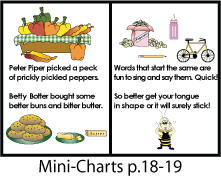 Say, “Let’s think of some words that start with the same sound. I’ll say the first ones and we’ll see if you can think of a color word that starts with the same sound.” Say, “Pig, penguin, porcupine...” Ask students to repeat your words before supplying another one. Then ask, “What sound do these words start with?” (/p/) You may have to exaggerate the beginning sounds until the students get the idea. Then ask, “What is a color word that begins with the same sound?” (pink, purple)
Say, “Let’s think of some words that start with the same sound. I’ll say the first ones and we’ll see if you can think of a color word that starts with the same sound.” Say, “Pig, penguin, porcupine...” Ask students to repeat your words before supplying another one. Then ask, “What sound do these words start with?” (/p/) You may have to exaggerate the beginning sounds until the students get the idea. Then ask, “What is a color word that begins with the same sound?” (pink, purple) - Say,“Let’s listen to this funny song and see if we can hear words that start with the same sound. You can sing along with the music on the parts of the song that repeat.” Play Sing Your Way Through Phonics Ready-to-Read! CD Track 2 and point to the Mini-Charts pages that illustrate the words. Students will be able to join in at the end of each verse (odd numbered pages on the Mini-Charts), if you lead them in the singing.
- Turn to page 18 of the Mini-Charts and practice saying the first sentence, “Peter Piper picked a peck of prickly pickled peppers.” Students should echo you. Ask, “What sound do most of these words start with?” (/p/)
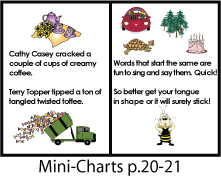 Practice saying the second sentence on Mini-Chart page 18, “Betty Botter bought some better buns and bitter butter.” Again, ask students to echo you and to identify the beginning sounds. (/b/)
Practice saying the second sentence on Mini-Chart page 18, “Betty Botter bought some better buns and bitter butter.” Again, ask students to echo you and to identify the beginning sounds. (/b/) - Say, “Now, can you say this sound - /t-t-t/?” “Let’s find a person in this book whose names start with the sound /t-t-t/.” Turn to Mini-Chart page 20 and say, “I’m going to read about two people on this page. One is Cathy Casey and the other is Terry Topper. Which one begins with the sound /t/--Cathy Casey or Terry Topper?” (Terry Topper) Read, “Terry Topper tipped a ton of tangled twisted toffee.” Ask students to echo you and ask again what beginning sounds were used in the tale of Terry. (/t/) Explain that when we say words that start the same really quickly, we call those words “tongue twisters.”
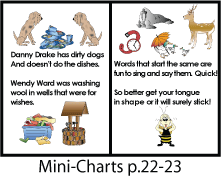 Say, “Now, let’s try the other tongue twister on this page. Cathy Casey cracked a couple of cups of creamy coffee.” Students should echo you. Ask, “What sound do these words start with?” (/k/) You may need to help students by repeating very distinctly the first two words, “Cathy Casey.”
Say, “Now, let’s try the other tongue twister on this page. Cathy Casey cracked a couple of cups of creamy coffee.” Students should echo you. Ask, “What sound do these words start with?” (/k/) You may need to help students by repeating very distinctly the first two words, “Cathy Casey.” - Repeat the procedure for Step 4, reading the first or second sentence on pages 22, 24, and 26.
- Play CD Track 2 again and ask the students to join in as much of the song as they can. Remind them to look at the pictures to help them remember the words. As you play the CD, tap the appropriate picture with your finger or pointer as you say each word that begins with the target sound. For example on page 26, you will tap the pile of marbles on the following words: Mandy-Monk-made-many-messy-mounds-muddy-marbles. If you are not using the Mini-Charts, use one picture card to represent the sentence with the repeated sound (e.g., /p/ pepper, /b/ butter, /c/ cup, /t/ truck, /d/ dog, /w/ well, /s/ spider, /f/ fire, /m/ marbles, /g/ garbage.)
 Turn to Mini-Chart page 19 and identify the four pictures at the top: popcorn, pencil, bottle, bicycle. Ask the students, “Which pictures start with the /p/ sound?” (popcorn, pencil) “Which pictures start with the /b/ sound?” (bottle, bicycle)
Turn to Mini-Chart page 19 and identify the four pictures at the top: popcorn, pencil, bottle, bicycle. Ask the students, “Which pictures start with the /p/ sound?” (popcorn, pencil) “Which pictures start with the /b/ sound?” (bottle, bicycle) - Repeat the procedure for Step 9 for the pictures on pages 21, 23, 25, and 27. Page 21 pictures are car, trees, turtle, cake. Page 23 pictures are walrus, deer, watch, ducks. Page 25 pictures are sun, frog, star, fish. Page 27 pictures are mop, gloves, grasshopper, monkey.
- Replay and sing CD Track 3 but allow two students to tap the pictures in time with the repeated sounds. You may need to guide them by holding their wrist and helping them tap at the appropriate times.
- Using the Pictures on Mini-Chart page 28, see if students can match each picture with another picture having the same beginning sound. Answers: sun/star, bottle/bicycle, trees/turtle, cake/car, fish/frog, walrus/watch, monkey/mop, gloves/grasshopper, ducks/deer, popcorn/pencil.
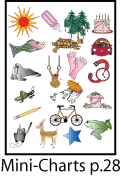
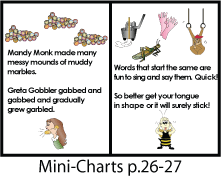
 Practice singing Tongue Tangle every day for a week. Then try singing the song with the instrumental track on the CD (Track 4). Do the students remember all the words to the song? Review any that are giving them difficulty and use the pictures on the Min-Charts to aid memory.
Practice singing Tongue Tangle every day for a week. Then try singing the song with the instrumental track on the CD (Track 4). Do the students remember all the words to the song? Review any that are giving them difficulty and use the pictures on the Min-Charts to aid memory. - Help students create other sets of tongue twister words for the song. Make 5 copies of Mini-Chart template p. 80 or 81. Help students come up with new words for the blanks in this way. First, think of an object or animal beginning with the chosen sound (e.g., penguin, puppy, porcupine, parakeet, pencil, pineapple, potatoes, pajamas). If students have trouble coming up with their own examples, let them choose from a list that you supply. Next, help students think of describing words, including colors, that have the same beginning sound (e.g., purple, pink, pretty, polka-dot, playful, pesty). Again, let students choose from your list to get them started. Choose two describing words and one object or animal to fill in the blanks (e.g., pretty pink potatoes, or playful purple penguins). Replace one or more verses of the song in this way. You do not need to replace all of the verses. Allow students to illustrate the new lyrics in the boxes on the Mini-Chart template. Place pages with new words in a 3-ring binder in page protectors and sing with the instrumental track on the CD (Track 4). If you have not replaced all the verses, sing the original verses on the parts of the song that do not have new examples.
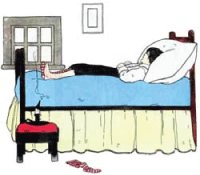 Practice discovering and creating tongue twisters in Nursery Rhymes like Wee Willie Winkie or Diddle Diddle Dumpling. Students indicate that they know which words have the same beginning sounds by performing some motion on those words. Examples: clapping, snapping, tapping bending, jumping, exercise movements. Omit the original words and help the students supply their own substitute words with another beginning sound. Examples: For the /m/ sound-“Mee Millie Minkie runs through the town.” or “Middle Middle Mumpling my son John.” This works especially well with Nursery Rhymes that include nonsense words.
Practice discovering and creating tongue twisters in Nursery Rhymes like Wee Willie Winkie or Diddle Diddle Dumpling. Students indicate that they know which words have the same beginning sounds by performing some motion on those words. Examples: clapping, snapping, tapping bending, jumping, exercise movements. Omit the original words and help the students supply their own substitute words with another beginning sound. Examples: For the /m/ sound-“Mee Millie Minkie runs through the town.” or “Middle Middle Mumpling my son John.” This works especially well with Nursery Rhymes that include nonsense words. - Read tongue twister stories and poetry and ask students to indicate that they recognize the repeated sounds by performing physical movements or playing rhythm instruments on the words with same beginning sounds. The Dr. Suess book, Oh Say, Can You Say? is good for this purpose.
- Students who know some of their letters and sounds can help spell or write words with beginning sounds that they create for the song and can help read those words in simple books like Busy Buzzing Bumblebees and Other Tongue Twisters by Alvin Schwartz and Kathie Abrams.
- Students sing all the words to the song on Mini-Charts pp. 18-27 without assistance, or
- Students indicate their recognition of rhyming words by making appropriate movements on the rhyming words, without assistance.
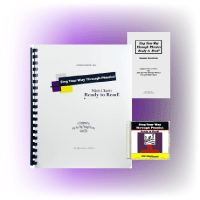 Order our cost-saving Sing Your Way Through Phonics Ready to Read Combo online ($33.95) containing the CD, Mini-Charts, Song Lyrics, and Teaching Suggestions — everything you need for this lesson! Or, print out an order form to mail/FAX to us.
Order our cost-saving Sing Your Way Through Phonics Ready to Read Combo online ($33.95) containing the CD, Mini-Charts, Song Lyrics, and Teaching Suggestions — everything you need for this lesson! Or, print out an order form to mail/FAX to us.